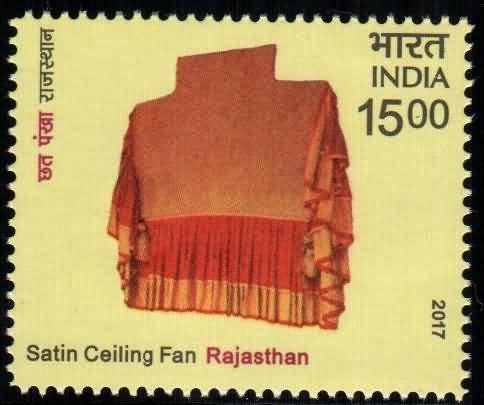Satin Ceiling Fan, Rajasthan

Technical Data
| Date of Issue | December 30, 2017 |
|---|---|
| Denomination | Rs.15 |
| Quantity | 100,000 |
| Perforation | 13 |
| Printer | India Security Press, Nashik |
| Printing Process | Wet Offset |
| Watermark | No Watermark |
| Colors | Multicolor |
| Credit (Designed By) | Ms. Nenu Gupta Shri. jatin Das |
| Catalog Codes |
Michel IN 3313 Yvert et Tellier IN 3004 Stanley Gibbons IN 3439 |
| Themes | Crafts |
The Royal Pankha of Rajasthan
Introduction
The Satin Ceiling Fan of Rajasthan is a magnificent example of India’s royal heritage and traditional craftsmanship. Known as the Pankha, this manually operated ceiling fan represents the luxury, artistry, and regal lifestyle of ancient Indian palaces. Adorned with silk and satin frills, it was once a symbol of royal elegance and comfort, used in the grand courts, temples, and mansions of Rajasthan.
Historical Background
Before the advent of electricity, India’s royal households relied on hand-pulled ceiling fans, operated by attendants known as Pankha-walas. These fans were suspended from the ceiling and moved back and forth using ropes that passed through pulleys, ensuring a continuous gentle breeze for kings, queens, and nobles.
In Rajasthan, the Satin Ceiling Fan became an integral part of palace decor and a reflection of grandeur. The fans were designed not just for utility but also to enhance the aesthetic beauty of royal interiors, often harmonizing with rich drapes, carved furniture, and ornate ceilings.
Design and Craftsmanship
The Satin Ceiling Fan showcases the exquisite artistry of Rajasthani artisans. Crafted with precision, these fans combine luxurious fabrics, delicate embroidery, and intricate design to create a masterpiece of both functionality and beauty.
Key features include:
- Silk and satin fabric adorned with colorful frills and tassels
- Handcrafted wooden or metal frame to provide structure and stability
- Suspension ropes and pulley mechanism for manual operation by a Pankha-wala
- Decorative trims and embroidery, often reflecting Rajasthani motifs and royal insignia
Each fan was made to complement the grandeur of the royal room it adorned, making it as much a piece of artistic heritage as a cooling device.
Cultural Significance
The Satin Ceiling Fan is more than just a relic of luxury—it symbolizes hospitality, grace, and tradition. In royal courts, the gentle sway of the fan not only offered comfort but also represented the royal attention and care bestowed upon guests and dignitaries.
Even in temples and havelis, large satin pankhas were used during rituals and ceremonies to fan deities, symbolizing devotion and reverence. In this way, the fan bridged the sacred and the regal, serving both gods and kings with equal elegance.
Commemorative Postage Stamp
To honor India’s traditional craftsmanship, the Department of Posts issued a commemorative postage stamp on the Satin Ceiling Fan of Rajasthan as part of its special series on Indian Hand Fans.
The stamp beautifully captures the fan’s luxurious satin texture, its elegant frills, and the nostalgic charm of India’s royal past. It serves as a tribute to the artistry of the Pankha-makers and the Pankha-walas, who together created and sustained this symbol of refined living.
A Legacy of Royal Elegance
The Satin Ceiling Fan stands today as a testament to India’s cultural opulence and craftsmanship. Beyond its practical purpose, it embodies a bygone era where art, comfort, and devotion intertwined seamlessly. With its shimmering satin folds and graceful movement, the royal Pankha continues to evoke the timeless allure of Rajasthan’s regal heritage—a whisper from the palaces of the past carried softly through the air.
